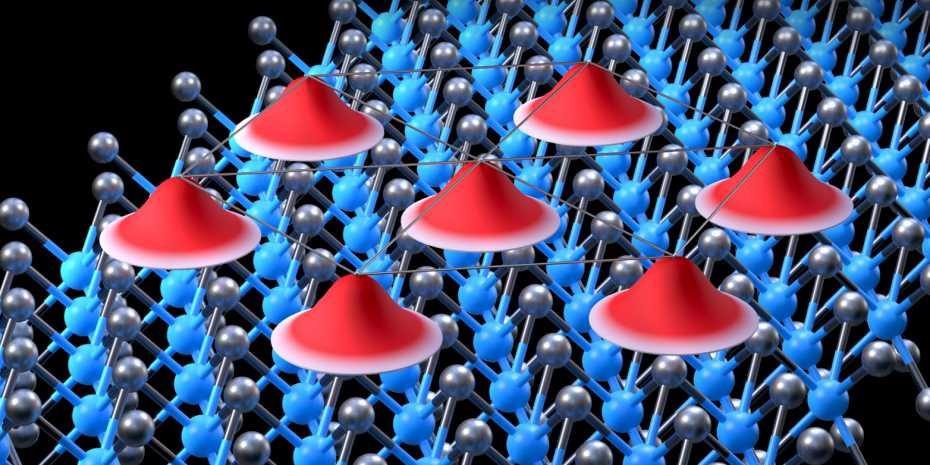Jul 2 2021
Scientists at ETH Zurich have been successful in observing a crystal that comprises only electrons. These Wigner crystals were predicted nearly nine decades ago but could be observed only now directly in a semiconductor material.
 A Wigner crystal of electrons (red) inside a semiconductor material (blue/grey). Image Credit: ETH Zürich.
A Wigner crystal of electrons (red) inside a semiconductor material (blue/grey). Image Credit: ETH Zürich.
Crystals have been appealing to people for a long time. Almost everyone admires the complicated patterns of a snowflake or the ideally symmetrical surfaces of a rock crystal. The magic does not cease even if one is aware that all this is just an interplay of attraction and repulsion between atoms and electrons.
A research group under the guidance of Ataç Imamoğlu, professor at the Institute for Quantum Electronics at ETH Zurich, recently generated a very unique crystal. In contrast to normal crystals, it is formed entirely of electrons.
Thus, the researchers have verified a theoretical prediction made nearly nine decades ago and which has, from then, been considered a type of Holy Grail of condensed matter physics. The study findings were recently reported in the scientific journal Nature.
A Decades-Old Prediction
What got us excited about this problem is its simplicity.
Ataç Imamoğlu, Professor, Institute for Quantum Electronics, ETH Zurich
Earlier in 1934, Eugene Wigner, one of the founders of the theory of symmetries in quantum mechanics, demonstrated that electrons in a material can organize themselves theoretically in normal, crystal-like patterns due to their mutual electrical repulsion.
The concept behind this process is a simple one: if the energy of the electrical repulsion between the electrons tends to be larger compared to their energy of motion, their arrangement will be done such that their entire energy is as small as possible.
But for the past several decades, this prediction continued to be completely theoretical, as those 'Wigner crystals' can form only under extreme conditions like low temperatures and a very small number of free electrons in the material.
This is partially due to the fact that electrons are several thousand times lighter compared to atoms, meaning that their energy of motion in an even arrangement is normally much greater compared to the electrostatic energy caused by the interaction present between the electrons.
Electrons in a Plane
Imamoğlu together with his collaborators solved these barriers by selecting a wafer-thin layer of the semiconductor material molybdenum diselenide that is just one atom thick and in which electrons can move only in a plane.
The team could alter the number of free electrons by adding a voltage to two transparent graphene electrodes, between which the semiconductor is interspersed.
As per theoretical considerations, the electrical properties of molybdenum diselenide should favor the development of a Wigner crystal — given that the entire apparatus is cooled down to a few degrees above the absolute zero of −273.15°C.
Merely generating a Wigner crystal, however, is not sufficient.
The next problem was to demonstrate that we actually had Wigner crystals in our apparatus.
Tomasz Smoleński, Study Lead Author and Postdoc in Imamoğlu’s laboratory, ETH Zurich
The distance between the electrons was estimated to be nearly 20 nm, or approximately 30 times smaller compared to the wavelength of visible light, and thus could not be resolved even with the help of the finest microscopes.
Detection Through Excitons
The physicists used a trick and managed to make the regular arrangement of the electrons visible although the separation in the crystal lattice was very small. For this purpose, they utilized light of a specific frequency to stimulate excitons in the semiconductor layer.
Excitons are nothing but pairs of electrons and 'holes' caused by a missing electron in the material’s energy level. The accurate light frequency for making such excitons and the speed at which they move rely both on the properties of the material and the interaction with other electrons in the material — for example, with a Wigner crystal.
The electrons’ periodic arrangement in the crystal causes an effect that can at times be seen on television. When a car or bicycle travels much faster, above a specific velocity, the wheels seem to stand still and to turn in the opposite direction.
The reason is the camera captures a snapshot of the wheel once in every 40 ms. If the evenly spaced spokes of the wheel move by exactly the distance between the spokes in that time, the wheel looks immobile.
In the same way, moving excitons seem to be stationary in the existence of a Wigner crystal, provided they move at a specific velocity determined by the isolation of the electrons in the crystal lattice.
First Direct Observation
A group of theoretical physicists led by Eugene Demler of Harvard University, who is moving to ETH this year, had calculated theoretically how that effect should show up in the observed excitation frequencies of the excitons — and that’s exactly what we observed in the lab.
Ataç Imamoğlu, Professor, Institute for Quantum Electronics, ETH Zurich
Unlike earlier experiments performed based on planar semiconductors, in which Wigner crystals were observed indirectly using existing measurements, this is a direct verification of the even arrangement of the electrons in the crystal.
With the help of the new technique, Imamoğlu and his collaborators hope to examine, in the future, precisely how Wigner crystals form out of a disordered 'liquid' of electrons.
Journal Reference:
Smoleński, T., et al. (2021) Signatures of Wigner crystal of electrons in a monolayer semiconductor. Nature. doi.org/10.1038/s41586-021-03590-4.